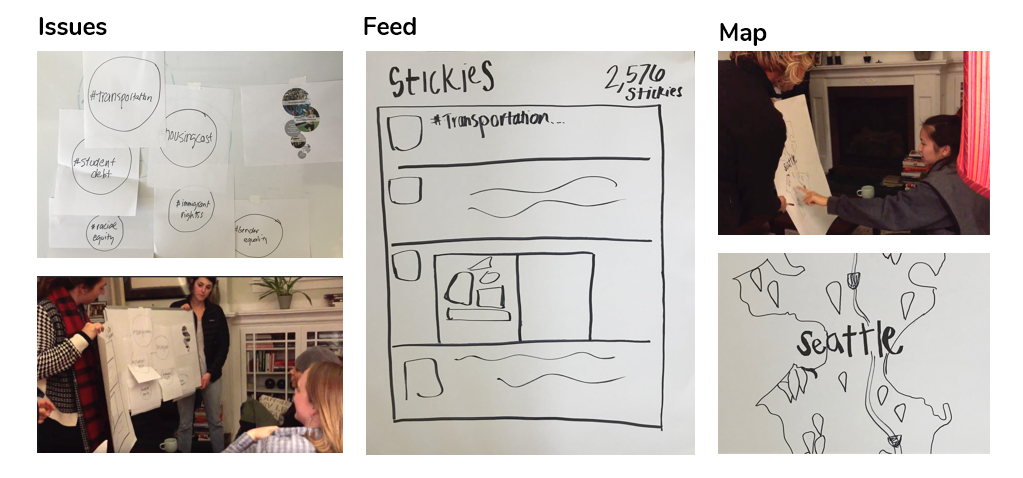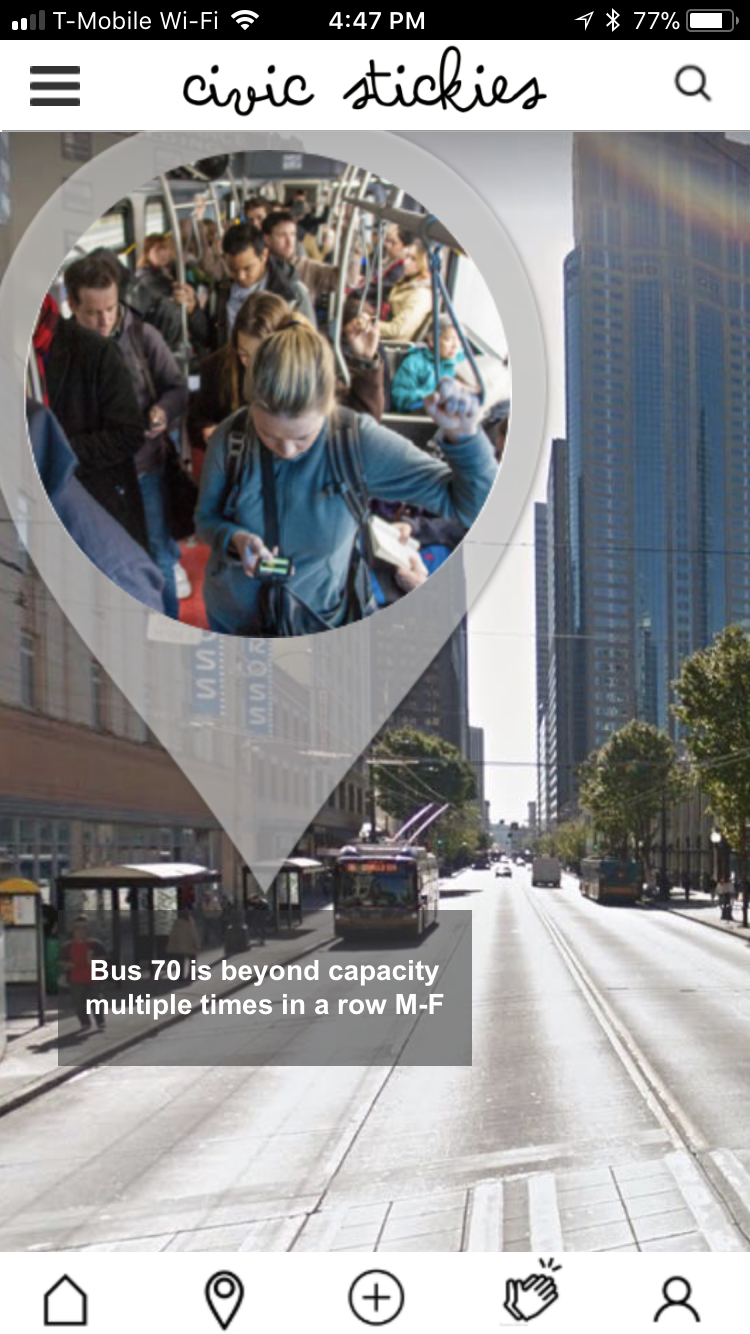Design Thinking Process
Qualitative Interviews, Research Analysis, Persona, Affinity Mapping, Prototyping
Jump to: 01. Define - 02. Research - 03. Analyze - 04. Ideate - 05. Prototype - 06. Test - 07. Refine
Summary
This project showcases the Design Thinking process to create a solution for a low youth voter turnout problem as part of a student-led project at the University of Washington. We'll dive deeper into each phase in the sections below.
My Role
Our team was comprised of four grad students. Each team member participated in all activities, and I paid special attention to the project management, user research, and prototyping.
- Project Management: Created timeline, managed tasks, ensured a timely submission of the deliverables.
- UX Research: Conducted interviews, synthesized insights into personas and design requirements.
- Ideation and Prototyping: Led affinity mapping exercise and built low and medium fidelity prototype.
Solution
Civic Stickies is an immersive application that lets you submit and explore civic issues in a fun, convenient, and community-driven way.
Hi-fidelity prototypes of the interactive kiosk and an AR app
01. Define
“How might we improve communication to increase voter turnout in local and state elections?”
As a student at the University of Washington, I was tasked with creating a design-for-good solution for a communication problem. My team identified low youth voter turnout as a problem space in need of a thoughtful design solution. We targeted Millennials, ages 18-34, as they will soon be the largest share of the electorate, yet they exhibit the lowest voter turnout.
Objectives
- Conduct research and draft persona
- Ideate solution and design a lo-fi prototype
- Conduct usability study
- Iterate on the prototype
02. Research
Research Methods
- Secondary research
- Online Survey
- Qualitative interviews
- Competitive analysis
Secondary Research
We conducted secondary research of existing recent research published on this subject and used information gathered to inform our survey and interview questions. Here are some of our key findings:
- Lack of outreach. Only 30% of young voters had been consulted by a party or campaign affiliate weeks before 2016 election. (Circle n.d.)
- Community oriented. “The media often labels Millennials as selfish. But studies show a generation focused on family, community and helping others.” (Jorgenson, K., The Guardian, 2016, September 28)
- Mobile first. Millennials don’t watch traditional TV channels or listen to the radio. They spend more time on their handheld devices and get most of their news from their smartphones. (Brooks, 2016)
Survey
We conducted an online survey exploring motivations and challenges with the voting processes. We collected responses from 74 respondents between ages 18 and 34 across Washington and California. Here are some of our key findings:
- Motivated to make a difference in the community. Of the respondents, 68% noted that they are motivated to vote when they are directly affected by the issues, 53% vote when they want to make a difference in their community, and 41% noted that they vote when they are passionate about a specific issue.
- Lack of trustworthy and unbiased information sources. Of respondents who do not plan to vote in the next state election, 67% don't feel informed enough about the candidates’ issues.
Qualitative Interviews
We used qualitative interviews to get deeper insights into voters’ motivations and barriers to voting. We interviewed 8 individuals with varying levels of participation in local elections. Here are some of our key findings:
- Socially fair issues. The interviewees indicated that they are interested in voting for issues that are socially fair.
- What are the impacts? Participants want to know the impact of the proposed policies on the communities.
- Real and inspiring candidates. Interviewees shared that connecting in person is very powerful for them and they are more likely to vote for a candidate they’ve met during an event.
- Lack of trustworthy information. Participants want access to easy-to-understand, unbiased, and credible sources of information.
- Registration and ballot processes are confusing. Many young individuals have yet to settle in one state and move for personal or professional reasons. Participants describe frustrations and confusion when registering to vote in a new state. Many have noted that the mail-in ballot (like in Washington state) makes it easy to submit a ballot, because they can avoid taking time off work, missing school, or arriving at the polling place after it closes.
- Families and friends impact voters’ education. Participants have shared that their parents' voting habits strongly influence their sense of civic duty to vote. Friends can also have an impact, as some interviewees learned about events or upcoming elections from their friends or roommates.
Selected quotes from our participants:
You can read a bunch of stuff, but actually seeing candidates and hearing what they say or feel is really beneficial to form an opinion about how you vote.” (P1)
“If people don’t even know there is an election going on then how are they supposed to vote in it?” (P3)
“If people are not exposed to issues [that other populations experience] they aren’t thinking about the issues.” (P3)
“The national elections feel more important but local (issues) are really more important; because they have more impact on our day to day life.” (P2)
Competitive Analysis
To better understand the existing landscape of information sources available to voters, we looked at existing platforms that provide prospective voters with information on candidates and issues.
03. Analyze
Persona
We synthesized our research findings into our persona.
Design Requirements
Using our persona, we have defined design requirements that address her needs. The solution should have a fun and social component, bring voters face-to-face with running candidates or speakers, be accessible on a laptop and mobile, bring people together to create a sense of community, and make an effort to provide credible information and present multiple angles of an issue.
O4. Ideate
Design Principles
We used our findings and persona to define design principles to serve as guidelines for our final solution.
Design Solutions
We brainstormed a wide range of solutions and used affinity mapping exercise to see trends and identify areas of opportunity. We shortlisted three potential solutions to select from:
- Civic Sidekick is the when and where for voting. The app reminds voters to register in time, searches for relevant civic events that fit into their schedule, and guides them through ballot submission process on the election day.
- CivicScope is the who and what of voting. It is a virtual reality experience that allows voters to meet candidates face-to-face and explore civic issues they would not experience otherwise.
- Civic Stickies is a public comment tool that relies on crowdsourcing from users, as they submit issues they want the government to focus on, and aims to address the why of voting. One of the challenges we’ve heard from Millennials is that current issues on the ballot are not relevant to them, or that they do not feel connected to candidates and issues. We have selected this idea as our design solution because it addresses persona's needs and aligns with our design requirements.
05. Prototype
Lo-Fi Prototype
Civic Stickies is an immersive application that lets Millennials submit and explore civic issues in a fun, convenient, and community-driven way. We prototyped lo-fidelity version of the app to test homepage navigation, adding a new issue, exploring issues, AR view, and searching.
We had several ideas for interactive kiosk and decided to use paper concept testing with a focus group to get feedback on our ideas. We wanted to understand how participants would expect to interact with such a kiosk and what kind of content they would like to see.
06. Test
Usability Study
We conducted a usability study with 6 participants in our target group. Here are our findings and implemented updates.
Findings
- Participants lacked a feeling of being “at home” on the homepage, and they did not understand where they were within the application.
- Participants want to see how candidates are addressing or planning to address posted issues.
- Participants enjoyed AR experience. However, the original flow had several entry points that caused confusion and need to be streamlined.
- Participants had mixed feedback on how they would want to interact with the kiosk. As for the content, they showed interest in seeing a live feed, a map, or a combination of the two.
Implemented Updates
- Added clear section for candidate responses.
- Re-organized structure of the homepage by making AR view the home page and moving the home page layout to the search results.
07. Refine
Scenario 1
Olivia is on her way to work in downtown Seattle when she sees a Billboard with an animated map of her city. Intrigued by the Billboard, she stops and starts exploring the map. It shows issues around the city, addressing different political and environmental topics.
Scenario 2
She finds out that the Billboard is connected to an application, called Civic Stickies, and decides to download the app. On her way to work, she receives a notification from the app. “There are stickies near you. Check them out!”. She decides to open the application to learn more. When she opens it, she is surprised to see the street she is walking on in the app. When she is holding up her phone, she can see that the street has a number of stickies on it. And as she is turning her phone, the view changes, too! One of her favorite features of the app is that she can see which politician supports the issues, and who thinks differently.
Scenario 3
The next day, Olivia notices how crowded her bus line is. She has to wait, and several buses go by her until she can finally catch a ride. She remembers the application she downloaded and decides to make a new post. She takes a picture of her crowded bus and posts it. She can now see her new sticky on the map, with the others she explored yesterday.
Scenario 4
Several weeks later, Olivia receives another notification on her phone. It says “Your sticky is being processed”. She finds out that there were many other app users, who complained about crowded bus lines, and therefore, the transportation office is looking into solving this issue. She also remembers that an election is coming
up, and decides to explore the app by issues; and, she reviews how candidates think about the issues she posted.
Watch a walk-through of the application
Next Steps
This solution is only a part of a larger system, to develop this idea further, we would need to consider:
- Policy changes take time to be implemented; so we would need to spend more time exploring candidate responses to user issues and build this out more.
- Users expressed interest in more community within the application including messaging, more movement on the home page and the ability to follow specific people or candidates. We want to look into that.
- We would also need to think about issues of privacy and user trust. This is a sensitive area for some users, and they might not want to share a lot of information about themselves when it’s connected to a specific opinion about policy.
- To complete the feedback loop, we would need to further develop the connection between the upvoted issues and upcoming elections.



























